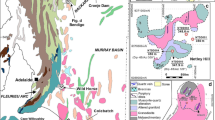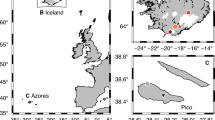Abstract
A new mineral, zvyaginite, a member of the epistolite group, has been found at Mt. Malyi Punkaruaiv, Lovozero Alkaline Complex, Kola Peninsula, Russia. It occurs in a hydrothermally altered peralkaline pegmatite and is associated with ussingite, microcline, aegirine, sphalerite, vigrishinite, and sauconite. Zvyaginite forms rectangular or irregular-shaped lamellae up to 0.1 × 1 × 2 cm in size when flattened [001]. The mineral is translucent to transparent and colorless, pearly-white, yellowish brownish, pale pink, or violet pink. The luster is nacreous on crystal faces and greasy on broken surfaces. Its Mohs’ hardness is 2.5–3. Zvyaginite is brittle. The cleavage parallel to {001} is perfect. D meas = 2.88(3), D calc = 2.94 g/cm3. The mineral is optically biaxial (−), α = 1.626(5), β = 1.714(3), γ = 1.740(5), 2V meas = 45(15)°, 2V calc = 55°. The IR spectrum is given. Chemical composition is as follows (wt %; average of five point analyses; H2O was determined using the modified Penfield method): 4.74 Na2O, 0.22 K2O, 0.77 CaO, 1.36 MnO, 0.24 FeO, 9.61 ZnO, 0.19 Al2O3, 29.42 SiO2, 12.33 TiO2, 27.22 Nb2O5, 1.94 F, 12.65 H2O, −0.82 −O = F2, for a total of 99.87. The empirical formula calculated on the basis of Si + Al = 4 is: Na1.24K0.04Ca0.11Mn0.16Fe0.03Zn0.96Nb1.66Ti1.25(Si3.97Al0.03)Σ4O15.07(OH)2.10F0.83(H2O)4.64. The simplified formula is: NaZnNb2Ti[Si2O7]2O(OH,F)3(H2O)4 + x (x < 1), Zvyaginite is triclinic, \(P\bar 1\), a = 8.975(3), b = 8.979(3), c = 12.135(4) Å, α = 74.328(9)°, β = 80.651(8)°, γ = 73.959(8)°, V = 900.8(6) Å3, Z = 2. The strongest reflections in the X-ray powder pattern (d, Å-I[hkl]) are: 11.72–100[001], 5.83–40[002], 5.28–53[−1–11, 112], 4.289–86[200, 021], 3.896–36[−1–12, −201, 003, 022, 113], 2.916–57[310, 132, 004], 2.862–72[130, 312]. The model of the crystal structure was obtained on a single crystal, R = 0.159. Zvyaginite and epistolite are similar in the structure of the NbTiSiO motif, but differ from each other in composition of O layer in HOH block. Zvyaginite is named in honor of Boris B. Zvyagin (1921–2002), Russian crystallographer, crystal chemist and physicist. The type specimen is deposited in the Fersman Mineralogical Museum, Russian Academy of Sciences, Moscow.
Similar content being viewed by others
References
Anthony, J.W., Bideaux, R.A., Bladh, K.W., and Nichols, M.C. Handbook of Mineralogy. II. Silica, Silicates, Tucson: Mineral Data Publ., 1995.
Back, M.E. and Mandarino, J.A., Fleischer’s Glossary of Mineral Species 2008, 10th Ed., Tucson: The Mineralogical Record Inc., 2008.
Borneman-Starynkevich, I.D., On chemical nature of murmanite, in Voprosy mineralogii, geokhimii i petrografii (Problems of Mineralogy, Geochemistry, and Petrography), Moscow: AN SSSR, 1946, pp. 66–74.
Brese, N. E. and O’Keeffe, M., Bond-valence parameters for solids, Acta Cryst., 1991, vol. B47, pp. 192–197.
Camara, F., Sokolova, E., Hawthorne, F.C., and Abdu, Y., From structure topology to chemical composition. IX. Titanium silicates: revision of the crystal chemistry of lomonosovite and murmanite, Group-IV minerals, Mineral. Mag., 2008, vol. 72, pp. 1207–1228.
Chukanov, N.V., Pekov, I.V., Zadov, A.E., et al., Mineraly gruppy labuntsovita (Minerals of Labuntsovite Group), Moscow: Nauka, 2003.
Ferraris, G. and Gula, A., Polysomatic aspects of microporous minerals — heterophyllosilicates, palysepioles and rhodesite-related structures, Rev. Miner. Geochem., 2005, vol. 57, pp. 69–104.
Gerasimovsky, V.I., To mineralogy of the southeastern Luyavrurt, in Tr. Lomonosovskogo In-ta AN SSSR, Ser. Miner., 1936, pp. 5–48.
Khalilov, A.D. The refinement of murmanite crystal structure and new data on its crystal chemical features, Mineral. Zh., 1989, vol. 11, pp. 19–27.
Khalilov, A.D., Makarov, E.S., Mamedov, K.S. and P’yanzina, L.Y. Crystal structures of minerals of the murmanite-lomonosovite group, Dokl. AN SSSR, 1965, vol. 162, pp. 179–182.
Khomyakov, A.P. Mineralogy of Hyperagpaitic Alkaline Rocks, Oxford: Clarendon Press, 1995.
Libowitzky, E. Correlation of O-H stretching frequencies and O-H⋯O hydrogen bond lengths in minerals, Monatsh. Chemie, 1999, vol. 130, pp. 1047–1059.
Lykova, I.S., Chukanov, N.V., Tarasov, V.P., et al., Ionexchange properties of murmanite, Na2Ti2(Si2O7)O2 · 2H2O, Russ. J. Physical Chem. B, Focus on Physics, 2013a, vol. 32, no. 4, 35–42.
Lykova, I.S., Pekov, I.V., Chukanov, N.V., et al., Ion exchange in lomonosovite, murmanite, and günterblassite: experimental data, Proceedings of Int. Conf. on Minerals as Advanced Materials III, Kirovsk, 2013b, pp. 11–12.
Nèmeth, P., Ferraris, G., Radnóczi, G., and Ageeva, O.A. TEM and X-ray study of syntactic intergrowths of epistolite, murmanite, and shkatulkalite, Canad. Mineral., 2005, vol. 43, pp. 973–987.
Pekov, I.V. Lovozero Massif: History, Pegmatites, Minerals. Moscow: ZemlyaOP, 2000.
Pekov, I.V., Britvin, S.N., Zubkova, N.V., et al., Vigri-shinite Zn2Ti4 −x Si4O14(OH,H2O,∟)8, a new mineral from the Lovozero alkaline complex, Kola Peninsula, Russia, Geol. Ore Deposits, 2013, vol. 55, spec. issue 7 (Zapiski Russian Mineral. Soc.), pp. 575–586.
Pekov, I.V., Chukanov, N.V., Ronsbo, J.G., and Sorensen, H., Erikite — a pseudomorph after vitusite, N. Jb. Miner. Monatsh., 1997, no. 3, pp. 97–112.
Rastsvetaeva, R.K. and Andrianov, V.I., New data on the crystal structure of murmanite, Kristallografiya, 1986, vol. 31, no. 1, pp. 82–87.
Semenov, E.I., Mineralogiya Lovozerskogo shchelochnogo massiva (Mineralogy of Lovozero Alkaline Pluton), Moscow: Nauka, 1972.
Sheldrick, G.M., A short history of SHELX, Acta Crystallogr., 2008, vol. A64, pp. 112–122.
Sokolova, E. and Hawthorne, F.C., The crystal chemistry of epistolite, Can. Mineral., 2004, vol. 42, pp. 797–806.
Vlasov, K.A., Kuzmenko, M.V., and Es’kova, E.M., Lovozerskii shchelochnoi massiv (Lovozero Alkaline Pluton), Moscow: AN SSSR, 1959.
Zabavnikova, N.I., Water treatment of the lomonosovite-group minerals, in Metody khimicheskogo analiza i khimicheskii sostav mineralov (Methods of Chemical Analysis and Chemical Composition of Minerals), Moscow: Nauka, 1967, pp. 69–78.
Author information
Authors and Affiliations
Corresponding author
Additional information
Original Russian Text © I.V. Pekov, I.S. Lykova, N.V. Chukanov, V.O. Yapaskurt, D.I. Belakovskiy, A.A. Zolotarev, Jr., N.V. Zubkova, 2014, published in Zapiski Rossiiskogo Mineralogicheskogo Obshchestva, 2014, No. 2, pp. 45–63.
A new mineral, zvyaginite, and its name, considered by the Commission on New Minerals and Mineral Names, Russian Mineralogical Society and approved by the Commission on New Minerals, Nomenclature, and Classification of Minerals International Mineralogical Association, October 2, 2013, IMA no. 2013-071.
Rights and permissions
About this article
Cite this article
Pekov, I.V., Lykova, I.S., Chukanov, N.V. et al. Zvyaginite, NaZnNb2Ti[Si2O7]2O(OH,F)3(H2O)4 + x (x < 1), a new mineral of the epistolite group from the Lovozero Alkaline Pluton, Kola Peninsula, Russia. Geol. Ore Deposits 56, 644–656 (2014). https://doi.org/10.1134/S1075701514080066
Received:
Published:
Issue Date:
DOI: https://doi.org/10.1134/S1075701514080066




